
Cybersecurity
In today’s interconnected world, cybersecurity has become a crucial aspect of our daily lives. With the rise in cyber threats, it’s essential to understand how to protect your personal and professional information from malicious attacks. This article will delve into the importance of cybersecurity, common threats, and best practices to keep your digital life secure.
What is Cybersecurity?
Cybersecurity refers to the practice of defending computers, servers, mobile devices, electronic systems, networks, and data from malicious attacks. It encompasses a variety of technologies, processes, and practices designed to protect your digital assets from cyber threats. Think of cybersecurity as your digital bodyguard, shielding your gadgets and online spaces from sneaky intruders. It’s like having a superhero squad for your devices, keeping them safe from bad guys trying to sneak in and cause trouble. From your laptop to your phone, cybersecurity locks the doors and stands guard against any digital mischief-makers. Using smart tech and clever tricks, it’s the invisible shield that keeps your digital world safe from harm. So, next time you browse the web or send an email, know that cybersecurity is your trusty sidekick, always ready to defend your digital turf.
Why is Cybersecurity Important?
As our reliance on technology grows, so does the risk of cyber attacks. These attacks can lead to significant financial losses, data breaches, and damage to personal and professional reputations. Key reasons why cybersecurity is vital include:
- Protecting Personal Information: Your personal data, such as social security numbers, bank details, and personal communications, can be exploited if not properly protected.
- Maintaining Business Integrity: Companies need to protect sensitive business information, trade secrets, and customer data from cybercriminals.
- Preventing Financial Losses: Cyber attacks can lead to direct financial loss through theft or fraud, as well as indirect costs associated with recovery and legal actions.
- Ensuring Continuity: Cybersecurity measures help ensure that businesses can continue to operate smoothly without disruptions caused by cyber incidents.
Common Cybersecurity Threats Explained in Simple Terms
1. Malware:
Malware is harmful software that includes viruses, worms, ransomware, and spyware. These can damage your computer, steal your information, or take control of your system without you knowing.
- Viruses: Programs that attach to files and spread to other files.
- Worms: Programs that spread across networks by themselves.
- Ransomware: Software that locks your files and demands money to unlock them.
- Spyware: Software that secretly watches what you do and sends information to the hacker.
2. Phishing:
Phishing is when someone tries to trick you into giving away sensitive information, like passwords or credit card numbers, by pretending to be a trusted person or company. For example, you might get an email that looks like it’s from your bank, asking you to enter your account details.
3. Man-in-the-Middle Attacks (MitM):
In a Man-in-the-Middle attack, a hacker secretly listens to or changes the communication between two people who think they are talking directly to each other. It’s like someone eavesdropping on a private conversation and changing the messages without anyone noticing.
Other Common Cybersecurity Threats:
- Trojan Horses: Malicious software that pretends to be something useful but harms your computer once installed.
- Adware: Software that displays unwanted ads on your computer, which can also lead to more dangerous malware.
- Rootkits: Programs that give hackers control over your computer while hiding from you and antivirus programs.
- SQL Injection: A method where hackers insert harmful code into websites to access and manipulate databases.
- Denial-of-Service (DoS) Attacks: When hackers overload a website with traffic, causing it to crash and become unavailable.
Understanding these threats can help you take steps to protect yourself online. Always be cautious with emails and downloads, use strong passwords, and keep your software up to date.
Best Practices for Cybersecurity
Implementing strong cybersecurity practices can help protect against these threats. Here are some essential tips:
- Use Strong Passwords: Create complex passwords that are difficult to guess and use different passwords for different accounts. Consider using a password manager.
- Enable Two-Factor Authentication: This adds an extra layer of security by requiring a second form of verification beyond just the password.
- Keep Software Updated: Regularly update your operating system, software, and applications to patch security vulnerabilities.
- Install Antivirus and Anti-Malware: Use reputable antivirus and anti-malware programs to detect and remove threats.
- Educate Yourself and Others: Awareness and education about the latest threats and how to counteract them can significantly reduce the risk of falling victim to cyber attacks.
- Secure Your Network: Use firewalls, secure your Wi-Fi with strong encryption, and consider using a Virtual Private Network (VPN) for added security.
- Backup Your Data: Regularly back up your data to prevent loss in case of a cyber attack or hardware failure.
Conclusion
Cybersecurity is an essential component of our digital lives, safeguarding us from numerous threats that lurk online. By understanding the importance of cybersecurity, recognizing common threats, and adopting best practices, we can protect our personal and professional information and ensure a safe digital environment.
Stay informed, stay vigilant, and stay secure.
-
Cybersecurity: Protecting Your Digital World

In today’s interconnected world, cybersecurity has become a crucial aspect of our daily lives. With
-
Unlocking the Secrets of Effective SEO: A Step-by-Step Guide

Understand Your Audience: Before diving into SEO strategies, it’s essential to understand your target audience.
-
Top 10 Websites Everyone Should Have Bookmarked: Your Online Resources

Enhance your online experience with our top 10 bookmarked websites, offering a diverse range from news and productivity tools to entertainment and shopping. Stay informed, organized, and entertained with these essential online destinations.
-
How To Make A Windows Bootable USB: Easy Way 2024

Nowadays, if you have to format a computer, you cannot format the computer by using
-
Digital Marketing Jobs: Opportunities, Roles and Pathways

Digital Marketing Jobs In today’s digital age, the demand for skilled professionals in the field
-
CCTV Cameras: Your Comprehensive Guide to Home Security

CCTC Camera






